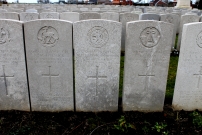| First Name: | William Edward | Last Name: | ROBSON | |
|---|---|---|---|---|
| Date of Death: | 17/08/1917 | Lived/Born In: | Victoria | |
| Rank: | Private | Unit: | London14 | |
| Memorial Site: | ||||
Current Information:Age-38 Born-Holloway Brandhoek New Military Cemetery3, Belgium
Third Battle of Ypres This was a campaign fought between July and November 1917 and is often referred to as the Battle of Passchendaele, a village to the north-east of Ypres which was finally captured in November. It was an attempt by the British to break out of the Ypres salient and capture the higher ground to the south and the east from which the enemy had been able to dominate the salient. It began well but two important factors weighed against them. First was the weather. The summer of 1917 turned out to be one of the the wettest on record and soon the battlefield was reduced to a morass of mud which made progress very difficult, if not impossible in places. The second was the defensive arrangements of concrete blockhouses and machine gun posts providing inter-locking fire that the Germans had constructed and which were extremely difficult and costly to counter. For 4 months this epic struggle continued by the end of which the salient had been greatly expanded in size but the vital break out had not been achieved. The Battle of Langemarck This took place between 16th-18th August, 1917 and was the second general attack of 3rd Ypres. Although it did not rain during the two days of the battle itself there had been plenty of it in the preceding days and in many places the battlefield was a quagmire. On the left of the attack in the north-west of the Ypres salient there was considerable success, especially for the French Army which attacked on the left of the British, but the attack on the Gheluvelt Plateau, due east of Ypres, met determined German resistance and the early gains were soon reversed. On 16th August, 56th Division attacked at 4.45am on the right of the battle front, with 169 and 167 Brigades their objective being the western half of Polygon Wood. 168 Brigade were in reserve and had been given a number of different tasks to facilitate the operation. At 11am the 14th London battalion moved forward from Chateau Segard to the southern edge of the Etang de Zillebeke where they remained until 9pm when they moved forward to Half Way House. During this latter move they sustained over twenty casualties, all from shell fire and nearly all among the battalion carrying party. Meanwhile the attack by 169 and 167 Brigades had ended in failure. A German counter attack drove both brigades back to their starting line. 14th London remained in these exposed positions, suffering more casualties, until relieved the following night. Nothing had been gained but many lives had been lost, including that of William Robson of 14th London who died from wounds on 17th August. |
||||
| « Back to Search Results | ||||
| If you think any of the information shown here is incorrect, Click Here to submit your amends and comments | ||||




